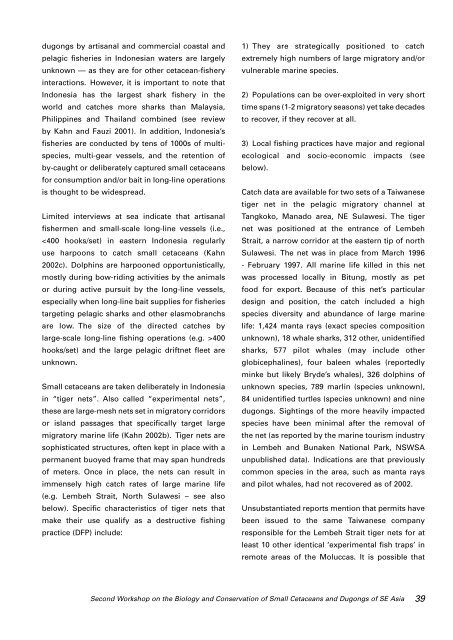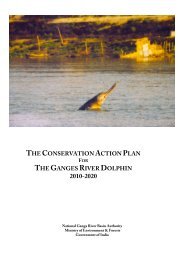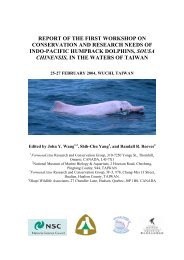Report of the Second Workshop on The Biology and Conservation of ...
Report of the Second Workshop on The Biology and Conservation of ...
Report of the Second Workshop on The Biology and Conservation of ...
Create successful ePaper yourself
Turn your PDF publications into a flip-book with our unique Google optimized e-Paper software.
dug<strong>on</strong>gs by artisanal <strong>and</strong> commercial coastal <strong>and</strong>pelagic fisheries in Ind<strong>on</strong>esian waters are largelyunknown — as <str<strong>on</strong>g>the</str<strong>on</strong>g>y are for o<str<strong>on</strong>g>the</str<strong>on</strong>g>r cetacean-fisheryinteracti<strong>on</strong>s. However, it is important to note thatInd<strong>on</strong>esia has <str<strong>on</strong>g>the</str<strong>on</strong>g> largest shark fishery in <str<strong>on</strong>g>the</str<strong>on</strong>g>world <strong>and</strong> catches more sharks than Malaysia,Philippines <strong>and</strong> Thail<strong>and</strong> combined (see reviewby Kahn <strong>and</strong> Fauzi 2001). In additi<strong>on</strong>, Ind<strong>on</strong>esia’sfisheries are c<strong>on</strong>ducted by tens <str<strong>on</strong>g>of</str<strong>on</strong>g> 1000s <str<strong>on</strong>g>of</str<strong>on</strong>g> multispecies,multi-gear vessels, <strong>and</strong> <str<strong>on</strong>g>the</str<strong>on</strong>g> retenti<strong>on</strong> <str<strong>on</strong>g>of</str<strong>on</strong>g>by-caught or deliberately captured small cetaceansfor c<strong>on</strong>sumpti<strong>on</strong> <strong>and</strong>/or bait in l<strong>on</strong>g-line operati<strong>on</strong>sis thought to be widespread.Limited interviews at sea indicate that artisanalfishermen <strong>and</strong> small-scale l<strong>on</strong>g-line vessels (i.e.,400hooks/set) <strong>and</strong> <str<strong>on</strong>g>the</str<strong>on</strong>g> large pelagic driftnet fleet areunknown.Small cetaceans are taken deliberately in Ind<strong>on</strong>esiain “tiger nets”. Also called “experimental nets”,<str<strong>on</strong>g>the</str<strong>on</strong>g>se are large-mesh nets set in migratory corridorsor isl<strong>and</strong> passages that specifically target largemigratory marine life (Kahn 2002b). Tiger nets aresophisticated structures, <str<strong>on</strong>g>of</str<strong>on</strong>g>ten kept in place with apermanent buoyed frame that may span hundreds<str<strong>on</strong>g>of</str<strong>on</strong>g> meters. Once in place, <str<strong>on</strong>g>the</str<strong>on</strong>g> nets can result inimmensely high catch rates <str<strong>on</strong>g>of</str<strong>on</strong>g> large marine life(e.g. Lembeh Strait, North Sulawesi – see alsobelow). Specific characteristics <str<strong>on</strong>g>of</str<strong>on</strong>g> tiger nets thatmake <str<strong>on</strong>g>the</str<strong>on</strong>g>ir use qualify as a destructive fishingpractice (DFP) include:1) <strong>The</strong>y are strategically positi<strong>on</strong>ed to catchextremely high numbers <str<strong>on</strong>g>of</str<strong>on</strong>g> large migratory <strong>and</strong>/orvulnerable marine species.2) Populati<strong>on</strong>s can be over-exploited in very shorttime spans (1-2 migratory seas<strong>on</strong>s) yet take decadesto recover, if <str<strong>on</strong>g>the</str<strong>on</strong>g>y recover at all.3) Local fishing practices have major <strong>and</strong> regi<strong>on</strong>alecological <strong>and</strong> socio-ec<strong>on</strong>omic impacts (seebelow).Catch data are available for two sets <str<strong>on</strong>g>of</str<strong>on</strong>g> a Taiwanesetiger net in <str<strong>on</strong>g>the</str<strong>on</strong>g> pelagic migratory channel atTangkoko, Manado area, NE Sulawesi. <strong>The</strong> tigernet was positi<strong>on</strong>ed at <str<strong>on</strong>g>the</str<strong>on</strong>g> entrance <str<strong>on</strong>g>of</str<strong>on</strong>g> LembehStrait, a narrow corridor at <str<strong>on</strong>g>the</str<strong>on</strong>g> eastern tip <str<strong>on</strong>g>of</str<strong>on</strong>g> northSulawesi. <strong>The</strong> net was in place from March 1996- February 1997. All marine life killed in this netwas processed locally in Bitung, mostly as petfood for export. Because <str<strong>on</strong>g>of</str<strong>on</strong>g> this net’s particulardesign <strong>and</strong> positi<strong>on</strong>, <str<strong>on</strong>g>the</str<strong>on</strong>g> catch included a highspecies diversity <strong>and</strong> abundance <str<strong>on</strong>g>of</str<strong>on</strong>g> large marinelife: 1,424 manta rays (exact species compositi<strong>on</strong>unknown), 18 whale sharks, 312 o<str<strong>on</strong>g>the</str<strong>on</strong>g>r, unidentifiedsharks, 577 pilot whales (may include o<str<strong>on</strong>g>the</str<strong>on</strong>g>rglobicephalines), four baleen whales (reportedlyminke but likely Bryde’s whales), 326 dolphins <str<strong>on</strong>g>of</str<strong>on</strong>g>unknown species, 789 marlin (species unknown),84 unidentified turtles (species unknown) <strong>and</strong> ninedug<strong>on</strong>gs. Sightings <str<strong>on</strong>g>of</str<strong>on</strong>g> <str<strong>on</strong>g>the</str<strong>on</strong>g> more heavily impactedspecies have been minimal after <str<strong>on</strong>g>the</str<strong>on</strong>g> removal <str<strong>on</strong>g>of</str<strong>on</strong>g><str<strong>on</strong>g>the</str<strong>on</strong>g> net (as reported by <str<strong>on</strong>g>the</str<strong>on</strong>g> marine tourism industryin Lembeh <strong>and</strong> Bunaken Nati<strong>on</strong>al Park, NSWSAunpublished data). Indicati<strong>on</strong>s are that previouslycomm<strong>on</strong> species in <str<strong>on</strong>g>the</str<strong>on</strong>g> area, such as manta rays<strong>and</strong> pilot whales, had not recovered as <str<strong>on</strong>g>of</str<strong>on</strong>g> 2002.Unsubstantiated reports menti<strong>on</strong> that permits havebeen issued to <str<strong>on</strong>g>the</str<strong>on</strong>g> same Taiwanese companyresp<strong>on</strong>sible for <str<strong>on</strong>g>the</str<strong>on</strong>g> Lembeh Strait tiger nets for atleast 10 o<str<strong>on</strong>g>the</str<strong>on</strong>g>r identical ‘experimental fish traps’ inremote areas <str<strong>on</strong>g>of</str<strong>on</strong>g> <str<strong>on</strong>g>the</str<strong>on</strong>g> Moluccas. It is possible that<str<strong>on</strong>g>Sec<strong>on</strong>d</str<strong>on</strong>g> <str<strong>on</strong>g>Workshop</str<strong>on</strong>g> <strong>on</strong> <str<strong>on</strong>g>the</str<strong>on</strong>g> <strong>Biology</strong> <strong>and</strong> C<strong>on</strong>servati<strong>on</strong> <str<strong>on</strong>g>of</str<strong>on</strong>g> Small Cetaceans <strong>and</strong> Dug<strong>on</strong>gs <str<strong>on</strong>g>of</str<strong>on</strong>g> SE Asia 39





